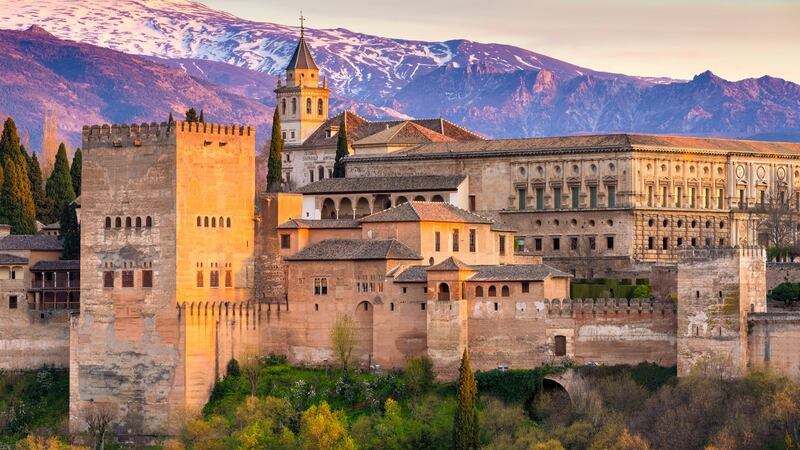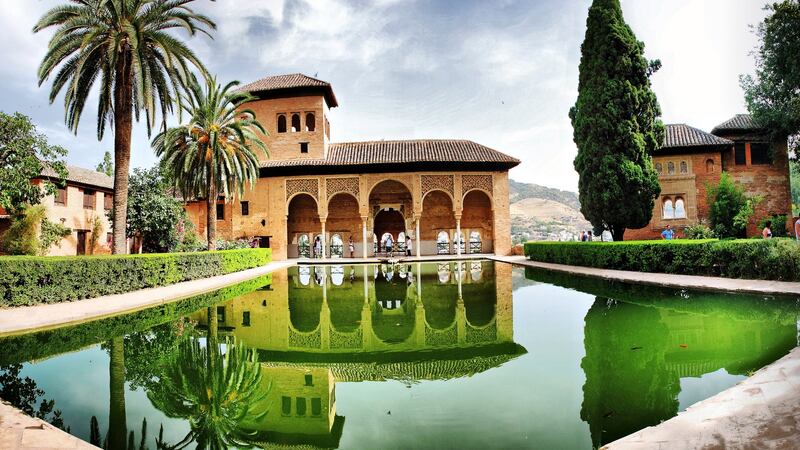Masseurs and masseuses glide through the dimly lit space, flitting between niches in the arched cavern. Diffused light enters through star- shaped skylights in the dome above. The tinkling fountains and exotic aromas suggest Marrakesh, Istanbul or even Damascus in better days, but the softly spoken snippets of language are unmistakably Spanish, and the beat of the background music is pure Andalucian.
Four different kinds of oil are lined up on a shelf for me to choose. I lift the lids on the metal containers and inhale deeply: rose, lavender, amber and, the most evocative and apt of all, pomegranate. Granada.
The Moors last ruled here 500 years ago. But the tradition of the hammam – the public baths later banned by the Spanish queen Isabella – is thriving once more at the Hammam al Andalus, an ideal stop after visiting the Alhambra, the building that defines Granada.


Today the Alhambra resonates with romance. But in the old days it was a place where power and passion, culture and cruelty, intrigue and beauty went hand in hand. The Alcazaba, with its high defensive walls, is the oldest part of the complex. The Moors took Granada in the eighth century, and by the 13th century the city's rulers held the only surviving Muslim Kingdom in Spain as the Reconquista swept south.
Climb the Torre de la Vela for a wonderful view of the city in one direction, the palace complex and the snow-capped Sierra Nevada in the other. Here, in 1492, the Cross was first displayed on the parapet wall along with the banners of Aragon and Castile, united by the marriage of Ferdinand and Isabella. The two are buried in the Capilla Real, a Gothic chapel built especially for that purpose in the city below.
Water was at the heart of the Alhambra’s design; the Rio Darro was diverted from 8km away to supply this city within a city. Its patios and gardens play with light and space, symmetry and reflection to create an interior world of serenity and beauty. The delicate stucco and tiling of the Palacio Nazaries is the highlight, a light-filled jewel box set inside the stark walls of the fortress. Here, in the lavishly tiled Salon des Embajadores, the last Muslim ruler signed the terms of surrender to the Catholic kings.
The Patio de los Liones (Court of the Lions) and its central fountain is the heart of the harem. While beautiful, it is difficult to avoid the selfies of thousands of tourists. But if you wait a few moments after a tour group goes through, you may just get a few minutes to yourself. Magical.
Further along, the Bano Reales (Royal Baths) are lit by pierced stars and lined with tile mosaics. Here the ladies of the harem would have bathed and gossiped as singers and musicians – reportedly blind so they could not see the women – entertained them from the balcony above.
After the Alhambra, the answer to all that walking is the Hammam al Andalus back in the centre. Slip down a side street alongside the Santa Ana church, whose bell tower used to be a minaret, and walk through the doors of a 13th-century building where, within an instant, you are transported to an oriental world.
An attendant hands you a striped cotton towel and draws you behind two layers of diaphanous curtains into an inner sanctum of brass sinks, intriguing scents and niches lit by tea-lights. After changing, you continue further into the gloom, where steam rises from the hot baths, incense fills the air and the outer world is left behind. All is shadows and mystery. The code is silencio: only very quiet talking is allowed as you enter this otherworld.
The building, centuries old, is thought to have been the original site of another hammam, though the Arabian baths are a complete reconstruction. The deepest, hottest pool, lined with blue, green and ochre tiles, soothes weary muscles and soon relaxes the mind as well. The only light is from behind wooden lattice windows set high in a domed ceiling. For the brave, there is a cold plunge pool, as well as a shallow, more tepid one for lingering.
A series of steps leads down to a central hot stone where aches disappear. Your masseur will call you to a niche in the wall and ask you to choose an oil for your massage. You can have a kese – a traditional scrub with something resembling a Brillo pad, which will leave your skin as soft as a baby's. After your massage, you float on air to the teteria upstairs for a mint tea.
Granada has many such tearooms, with inlaid tea tables, hookah pipes and impossibly sweet and delicious pasteles. It is also renowned for its tapas and prides itself on being more generous than many Andalucian cities by still giving a free tapa or pinxto with a glass of fino, the sherry of Jerez.
Stroll through the university quarter or head for the Campo del Principe and take your pick of the row of establishments, which might give you some berengena frito (fried aubergine ) or other titbit to accompany your aperitif. Pick one that is full of local people and eat your fill of albondigas, jamon iberico and anything with seafood.
The best way to end your visit to Granada is to climb the hill opposite the Alhambra, threading your way through the lanes and up the steep stairs of the old Moorish neighbourhood of the Albaicin.
As sunset approaches, sip a glass of cava on the terrace of the Restaurant Mirador de Morayma as the great walls of the Al Qal'a al-Hambra – the Red Fort – change colour like autumn leaves. Later, floodlights outline the fairytale shapes of its palaces and towers, spires and gates.









